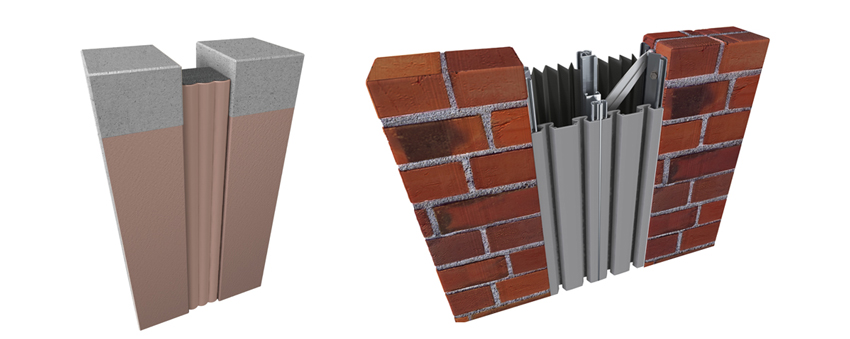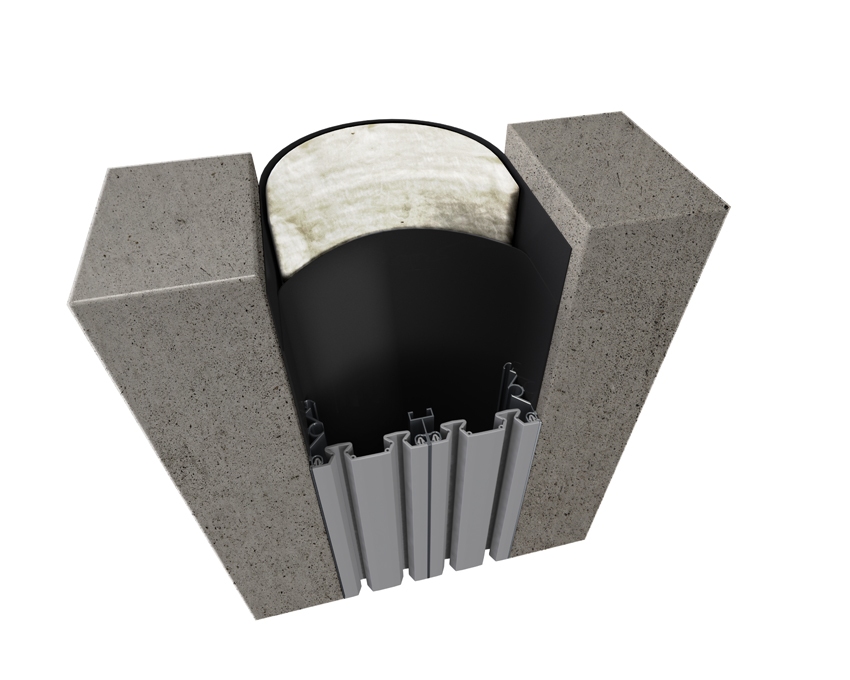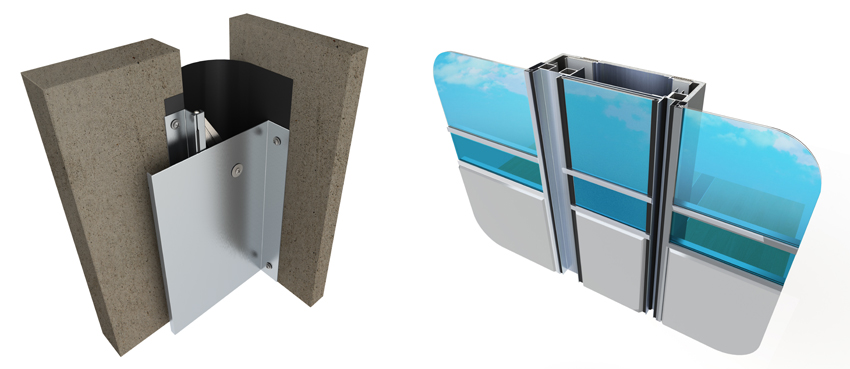Creating High-Performance Building Facades
Between the Lines: Choosing Expansion Joint Filler Systems
All facade materials and systems are made up of distinct parts or sections. The edges of those sections abut each other and require the use of a material to seal the joint between them. Similarly, on larger buildings, intentional expansion joints (gaps) are needed in the structure to allow for the movement of different parts of the building due to thermal expansion and contraction, seismic loads, or other conditions. Since all of these types of joints can interrupt the thermal, moisture, and air barriers in a facade, how they are treated and addressed will determine the continuity, or not, of these barriers across the joints.
From the standpoint of their performance, the key to successful joints often comes down to the selection of the material or type of system used to fill the gap in the joint. Effective choices include the use of manufactured foam seals, infilled “pan” systems, and metal cover systems. We will look at some of the choices below and comment on their suitability for different facade applications.
Closed-Cell Foams
Closed-cell foams are very watertight and do not allow the moisture to enter the body of the foam. This is the best application for horizontal runs where water could pool. These are tougher to compress but can be placed under tension or be pulled to expand quite well. The other key advantage of closed-cell foams is that they take well to heat-welding of seams. This renders a monolithic installation that reduces the risk of water infiltration.
A good rule of thumb/best practice when using closed-cell foam seals is to limit their application to a joint width of no more than 8 inches (200 millimeters) or smaller. Use of foams for expansion joints larger than even 6 inches leads to two things:
- Exceeding the foam’s performance characteristics. Plus, the weight of “super-wide” foam seals can lead to sagging in vertical applications.
- Dramatically higher costs compared to other expansion joint cover systems.

Images courtesy of Inpro
Foams and pleated seals can be used in narrow joint openings and compress or expand in relation to the building movement. They may not be the most cost-effective choice in some cases, however.
Open-Cell Foams
Yes, these products do allow for some flow-through of water vapor. Like many exterior veneer systems, if moisture becomes trapped in a wall cavity, building systems allow the moisture to wick out. This is a good attribute and a major focus to eliminate potential mold issues in vertical applications. Hence, open-cell foams should be employed only in vertical installations, where gravity can wick any absorbed water downward and away from the building enclosure.
Architects should also be aware that open-cell foams for expansion joints come in a maximum length of 5 feet, and because they are not heat-weldable, caulk must be used at the seams. This can introduce a future failure point as well as higher periodic inspection and maintenance costs should the seams need to be repeatedly re-caulked to prevent leakage. It is also important to know that while in a compressed state all foams may look the same, they are not.
Pleated Seals
As their name implies, pleated-seal joint systems are installed into a blocked-out joint area, and they absorb movement through compression and expansion of the pleats in the seal. The rubber-looking, corrugated joint material is also an excellent option for exterior application where waterproofing is required. These seals are best employed for heavy pedestrian and moderate vehicle loading. Proper use of two-part epoxies ensure solid adhesion to the deck, and heat-welded seams ensure watertight performance. The nominal joint width for these systems should not exceed 31⁄2 inches to 43⁄8 inches (89 to 111 millimeters) since the material cannot really handle wider applications than that. Since these are often left exposed, building facade aesthetics can be enhanced using colored compression seals.
Metal Covers
For larger openings on facades that require greater durability, it is often more economical and appropriate to use a metal expansion joint cover system. These systems rely on base elements that are secured to either side of the building joint with a cover plate that allows the building to move behind it. Properly fabricated and installed, these systems can be weathertight by using a flexible barrier behind the metal.

Image courtesy of Inpro
Insulated vapor barrier (IVB) expansion joint filler systems provide exterior facades with the needed movement while maintaining the equivalent R-values needed in walls.
Infilled Pan Systems
For cases where the appearance of the exposed metal cover plate is not desired, there is another option. Some metal systems are designed to receive a finish material in the center portion of the expansion joint cover while minimizing the exposed joint filler material. Referred to as an infilled pan system, these can be appealing for exterior and interior locations where larger joints need to be filled and durability addressed all in a manner that blends in with the general appearance of the surrounding surfaces, such as a building facade.
Vapor and Thermal Control
Regardless of the type of expansion joint filler system that is used, facades need to retain control of vapor and thermal transfer. For vapor or moisture control, one solution that can be used is to employ a reinforced vapor barrier (RVB) to prevent water infiltration or channel water to drain locations via an integrated drain tube. Most designers consider the RVB as the go-to standard for exterior wall expansion joints since they are a durable membrane that resides within the joint. They not only accommodate movement but also prevent the penetration of air, debris and pests from entering through the joint. The critical factor in installation of an RVB expansion joint system is to apply a bed of manufacturer-approved butyl sealant in the concrete block-out area or along the frame along the entire length of the expansion joint. This will aid in securing the moisture barrier to the concrete block-out and provide a watertight seal to prevent seepage around the perimeter of the joint. To work properly, always leave enough drape in the moisture barrier to ensure the system will be able to fully open to its maximum distance without interference from the expansion cover components.
Thermal performance in expansion joints is often overlooked in building design but is no less important than air and moisture performance. There is some minor insulating benefit from RVB joint systems, but an insulated vapor-barrier (IVB) system should be considered wherever thermal performance is important. The addition of insulation within the dual-walled vapor barrier provides a higher R-value—and the benefit, of course, is that the R-value works in both directions. Heat or cold do not penetrate the joint, and interior occupant comfort and HVAC performance are better shielded from the outside conditions along the entire length of the joint. IVBs are also capable of providing up to 50 percent movement, making them a seismic-capable system. They are suitable for use in expansion gap sizes from 6–28 inches.

Images courtesy of Inpro
Metal covers and infilled pan systems allow expansion joints to be covered and sealed in facades to provide the needed protection and durability.
Tying In to Work of Other Trades
Expansion joints do not exist by themselves; they must be tied in to adjacent construction systems installed by other trades. Besides concrete, this can include wood framing, steel decking, steel studs and joists, exterior finish systems, masonry, and even glazing systems. The challenge—and frankly a potential failure point—is the reliance on the skilled craftsmen and women to tie their particular installation into adjacent materials and systems well. For instance, if the glazing specification and bid documents allow the glazing contractor to simply install the frame and glass and do not demand tie in to say an adjacent waterproof vertical expansion joint, it invites problems. The same thing works the other way too. If a waterproofing contractor installs the expansion joint system and does not tie in to the window glazing, the seal is not complete.
Conclusion
It is possible to create building facades with more design flexibility and better performance than in previous times. Opaque areas can be clad using innovative systems and materials such as veneer stone, ultra-high-performance concrete, or sintered stone. Glazed areas can benefit from improvements in fenestration systems and architectural glass. Protecting the integrity of facades can be enhanced by the best selection of expansion joint systems. Altogether, architects can achieve the desired performance without sacrificing design intent in building facades by understanding these systems.
Peter J. Arsenault, FAIA, NCARB, LEED AP, is a nationally known architect and prolific author of over 225 continuing education articles advancing building performance through better design. www.pjaarch.com, www.linkedin.com/in/pjaarch
View Course Libraries for:
Notice

www.azonintl.com

www.hofmann-facades.com

www.inpro.com

www.neolith.com

www.vitroglazings.com













